| Article ID | Journal | Published Year | Pages | File Type |
|---|---|---|---|---|
| 1946709 | Biochimica et Biophysica Acta (BBA) - Gene Regulatory Mechanisms | 2011 | 9 Pages |
Expression of hypophysiotropic TRH, that controls thyroid axis activity, is increased by cold exposure; this effect is mimicked in rat hypothalamic cells incubated with norepinephrine or cAMP analogs. TRH proximal promoter contains three putative CRE: Site-4 or CRE-1 that overlaps an element recognized by thyroid hormone receptors, CRE-2 with adjacent sequences GC box or CACCC recognized by Sp/Krüppel factors (extended CRE-2), and AP-1 sites flanking a GRE1/2. To evaluate the role of each element in the cAMP response, these sites were mutated or deleted in rat TRH promoter linked to luciferase gene (TRH-luc) and co-transfected with β-gal expression vector in various cell lines; C6 cells gave the highest response to forskolin. Basal activity was most affected by mutations or deletion of CRE-2 site, or CACCC (50–75% of wild type—WT). Forskolin-induced 3× stimulation in WT which decreased 25% with CRE-1 or AP-1 deletions, but 50% when CRE-2 or its 5′ adjacent GC box was altered. SH-SY5Y cells co-transfected with CREB-expression vector increased dB-cAMP response in the wild type but not in the CRE-2 mutated plasmid; cotransfecting CREB-A (a dominant negative expression vector) strongly diminished basal or cAMP response. Primary cultures of hypothalamic cells transfected with plasmids containing deletions of CRE-1, CRE-2, or extended CRE-2 failed to respond to forskolin when CRE-2 was modified. These results corroborate the CRE-2 site as the main cAMP-response element of rat TRH promoter, not exclusive of transcription factors of hypothalamic cells, and stress the relevance of adjacent Sp-1 sites, important mediators of some metabolic hormones.
Research Highlights►Forskolin or cAMP stimulates TRH transcription in various cell types. ►Mutations in CRE-1 (Site-4) had little effect on basal or cAMP-induced transcription. ►CRE-2 (TGCCGTCA) of TRH promoter is the most important site for cAMP response. ►Sp/KFL sites adjacent to CRE-2 participate in basal or forskolin-induced activity. ►Transcription was reduced by expression of a dominant negative CREB.
